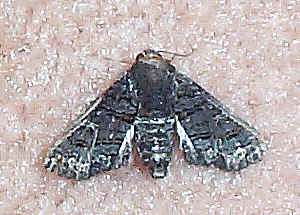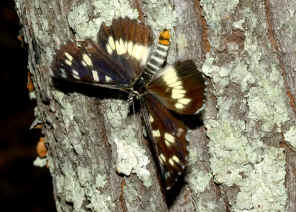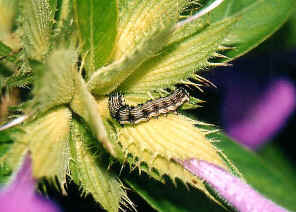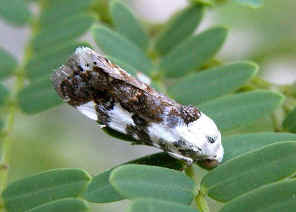Noctuid Moths - Family Noctuidae
This page contains pictures and information about moths and caterpillars in family NOCTUIDAE that we found in the Brisbane area, Queensland, Australia.

- Armyworm Caterpillar length 30mm
The Caterpillars of NOCTUIDAE are usually smooth, or with very little hairs. They are from small to large size. Most are active at night.
Some NOCTUIDAE caterpillar are called Cutworms, some
called Armyworms and some called Semi-loopers. Cutworms live in soil surface.
They bite off young plants at ground level and pull them into their burrow.
Armyworms eat their way across like an army on the march. Semi-loopers loop their bodies when moving as the
Caterpillars of the family GEOMETRIDAE.
Most NOCTUIDAE pupate in the soil but some pupate under
a leaf of their food plant.
The adults mainly fly at night. They usually feed on
nectar from flowers, some feed on ripe fruit. They are from small to large size.
Usually they are dull in colour, but some have colourful hindwings.
NOCTUIDAE is the largest family of moth. We found many of them in Brisbane and listed as follow.
Subfamily CATOCALINAE
- We found many moth species in this subfamily. They are listed in the separated page - CATOCALINAE.
Subfamily EUTELINAE
- Noctuid Moth
-

- Pataeta carbo, body length 25mm
- We found this moth inside our house. The caterpillar feeds on Eucalyptus.


- We found another one outside our house on March 2007.
Subfamily CHLOEPHORINAE
- Transverse Moths


- Xanthodes transversa, caterpillar length 50mm, adult wingspan 30mm
- We sometimes find this Transverse Moths caterpillars on our Hibiscus plants in our backyard. When small, the caterpillars are light green in colour. Later they develop yellow bands and black spots. The adult Transverse Moth is yellow in colour, with three brown arrow-shaped lines across each forewing. The back edges of the forewings are dark brown in colour. More pictures and information please click here.
- Tobacco Looper
-


- Chrysodeixis argentifera, wingspan 30mm
-


- This moth is common in early summer in bush near the creek.

- The caterpillar is semi-looper, green in colour with thick darker green line on its back. It feeds on different of agricultural and garden plants include tomato, beans and sunflowers.
- Reference:
- 1. Chrysodeixis argentifera - Caterpillars of Australian, by Don Herbison-Evans & Stella Crossley, 2007.
- 2. Moths of Australia - I. F. B. Common, Melbourne University Press, 1990, Fig 48.15.
- 3. Insects of Australia - CSIRO, Division of Entomology, Melbourne University Press, 2nd Edition 1991, p914.

- Picture taken on Dec 2007, Bulimba Creek near Sunnybank.
- Bird-dropping mimicking Noctuid Moth


- ? sp., length 25mm
- Pictures taken outside our house during mid summer. This moth mimics bird-dropping.
Subfamily PLUSIINAE
Subfamily ACRONICTINAE - AMPHIPYRINAE
- The adults of this two subfamilies cannot not be readily separated from each other. Sometimes this two subfamilies are treated as one subfamily. We found many moth species in this combined subfamily. Details please see in the ACRONICTINAE - AMPHIPYRINAE page.
Subfamily AGARISTINAE - Dayflying Moths
- Moths in this subfamily are active during the day time. Caterpillars are colourful, also feed openly during the day.
- Reference:
- 1. Moths of Australia - Bernard D'Abrera, Lansdowne Press, Melbourne, 1974, p78.
- Joseph's Coat Moth, Painted Vine Moth


Agarista agricola, caterpillar length 40mm - We found quite a number of those caterpillars feeding on grape vine in Daisy Hill during late summer. The caterpillars have alternate black and white bands with some orange bands. They have sparse black thick hairs. The adult moths are day flying, with black, red, pale blue and yellow colours.
- Crow Moth


- Cruria donowani, wing span 45mm
- The moth looks like a Crow Butterfly with a bit smaller size. It is black in colour with white spots form a cat-face pattern on wings. Its abdomen is black and white banded with orange segments at the tip. It is believed those butterflies and moths with similar wing pattern form a Mullerian mimicry complex to avoid predator. Please check this page for more information and pictures.
- Native Budworm


- Helicoverpa punctigera, length
20mm
Moth, wingspan 40mm
- We sometimes found this caterpillar feeding on flower bud. We even found this caterpillar inside a strawberry. This Caterpillar has black dots and pattern of thin dark lines running along the body. Those lines are darker around the second and third segments. The adult moth is brown in colour. Click here for more information.
- Corn Ear Worm, Tomato Grub, Tobacco Budworm, Cotton Bollworm


- Helicoverpa armigera, wingspan 40mm
- On the vegetable (Beans) we brought, we found a small caterpillar, which look similar to the Native Budworm caterpillar above but green in colour. We feed it with vegetables and a week later it turn into a pupa. Two weeks late it turn into the moth, as shown in the above pictures.
- Reference:
- 1. Helicoverpa armigera - Caterpillars of Australian, by Don Herbison-Evans & Stella Crossley, 2007.
- 2. Moths of Australia - I. F. B. Common, Melbourne University Press, 1990, Fig 50.8.



Subfamily Acontiinae
- Bird-dropping Moth

- Acontia nivipicta, Acontiinae, body length 12mm
- This moth mimics bird dropping. It did not move even with our very close watching. It flied away only when we used a small stick to disturb it.
- Reference:
- 1. Acontia nivipicta - Insects of Townsville, Australia - Graeme Cocks, 2004.
- We sometimes found this caterpillar feeding on flower bud. We even found this caterpillar inside a strawberry. This Caterpillar has black dots and pattern of thin dark lines running along the body. Those lines are darker around the second and third segments. The adult moth is brown in colour. Click here for more information.
Subfamily HELIOTHINAE
Unknown Noctuid Caterpillars
Followings are caterpillars that yet to be identified. Please advise if you known what are they.
- Dark-brown Unknown Caterpillar


- Caterpillar length 50mm
- The above caterpillar turn into a pupa, but this pupa never turn into a moth.
- Reference:
- 1. NOCTUIDAE - Andreas Zwick, CSIRO Entomology, Australian Biological Resources Study, Department of the Environment and Water Resources, 2006.
